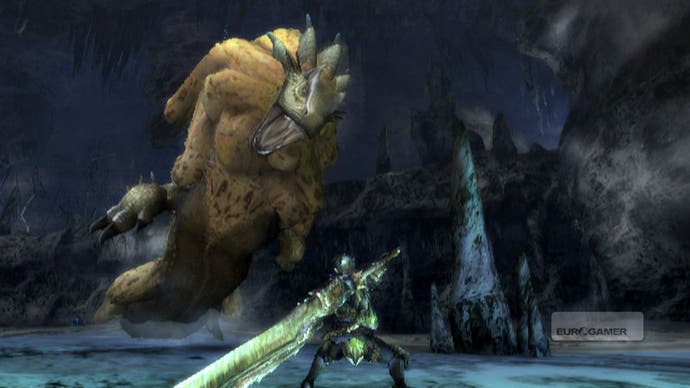Monster Hunter Tri
Tri force.
Monster Hunter is, fittingly, quite the behemoth - a massive game in terms of both content and, elsewhere, popularity. To extend that analogy, it's also a game which has always tended to either consume people entirely, or frighten them off before they've really had a chance to engage with it.
It's seen tremendous success in Japan, being a massive system-seller for the beleaguered PSP, but a steep difficulty curve and a lack of sensible online options have always relegated it to the status of a niche classic in the West. It makes sense, then, that its appearance on Wii with Tri is an attempt to address those issues.
However, Monster Hunter is in the awkward position of seeing many of the same points on both sides of its love/hate balance sheet. To some extent, ameliorating the concerns of the haters would mean alienating an incredibly dedicated and loyal fanbase.
Happily, Tri has done an excellent job of juggling these concerns, shaving the thin edge of the wedge enough to bring new players into the fold without trivialising the satisfaction and sense of incredible achievement which the tougher challenges in the endgame provide.

For anyone who's played a Monster Hunter game before, this is immediately apparent in the opening stages. Freedom Unite, the previous title, had a 'tutorial' section which lasted hours, with sudden difficulty spikes and viciously unforgiving battles waiting just beyond to drive off all but the most determined. Tri's beginning is a totally different affair, introducing the game's mechanics in easily digestible chunks without asking the same leaps of faith in deferred gratification.
It's still about eight hours before players will find themselves involved in the real meat of the game - whittling down the towering bastards who stalk the various environments and making them into weapons and armour - but everything leading up to that has been streamlined and explained in a far more enjoyable way.
Monster Hunter, you see, isn't just about hunting monsters. Getting to the stage where your hunter is well-equipped enough to take on one of the big boys is a hugely involved process of gathering, crafting, and honing technique. There's no experience, no levelling up - the only things you'll be improving are your equipment and inventory, from your weapons and armour to the huge array of potions, philtres and buff items.

Monsters drop unique materials, which combine with more mundane items to produce themed armour sets and weaponry, usually with some of the qualities of that monster imbued within them. Head out and collect a few basic ores and you can visit the blacksmith to furnish yourself with a basic sword or breastplate, but to make anything more interesting you'll need to get out there and kill some stuff, carving skin and bones from the still-warm corpses to craft with. Now you're tougher, so you can go and kill some bigger stuff, meaning you can make better kit. Repeat, ad infinitum.
It makes for fantastically well-balanced and compulsive progression, each round of improvements bringing new challenges and advantages as you build your stockpile. As well as being crafted from scratch, weapons and armour can also be improved further from existing pieces, with the weapon trees in particular branching into wonderfully involved and inventive new forms across the seven classes. However, collecting materials also necessitates a lot of grind, repeating quests to slay the same monsters again and again as you harvest bulk materials and seek out elusive rares.


